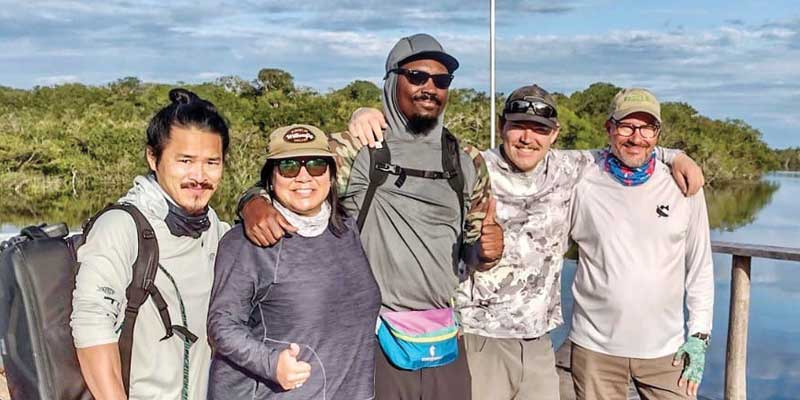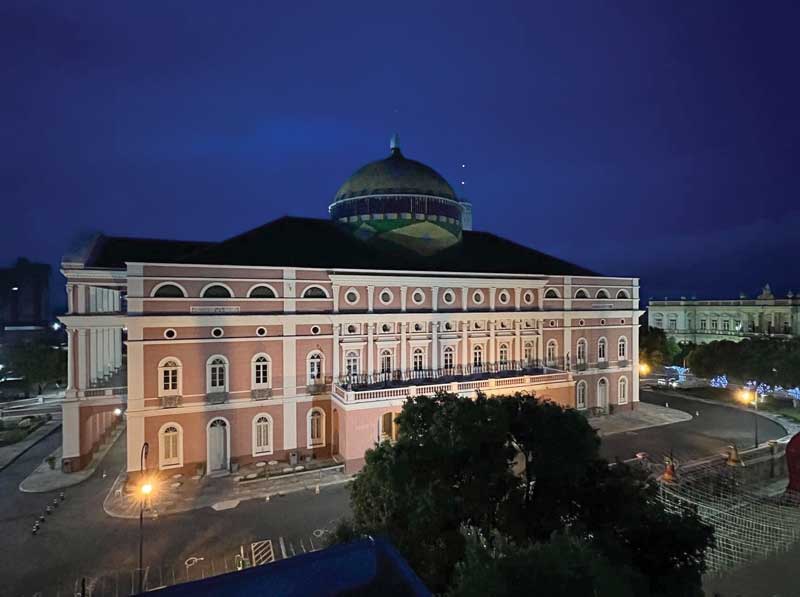It was late October, and I was sitting by the fireplace, warming up and looking through my emails. I noticed an odd subject title “Slightly Crazy Question…” The email was addressed from none other than the Angler in Chief of FishTalk Magazine, Lenny Rudow. He asked if I would be interested in an Amazon Fishing Press trip. I said yes!

As all good adventures do, mine started at home. Sandy, my wife, was starting dinner when I asked if I should try to take up the offer from Visit Brazil to attend. The trip, a whirlwind 11-day adventure, would take me to and around Amazonia, Brazil, visiting its culture, people, sites, and some fishing, too. So, I made the ask to Sandy. There was stillness in the air, silence, and then a stink eye and something about catching some weird jungle disease. We talked; I said I would check into it and promised to take all precautions. After talking with a representative who works with Brazil Tourism, I said, “I’m in!” The trip was just a month out. I needed to get a yellow fever vaccine and verify I was up to date on Covid vaccines as well. It was crunch time!
On day one, I got up early and drove to Baltimore to catch my flight to Miami, FL. In Miami I had a nine-hour layover as I was the first to arrive of our group. Other members of the press group would arrive throughout the day. The next leg of the trip took us over the equator, a layover, and getting through customs in Brasilia, Brazil, and onto Manaus, which is located in the state of Amazonia. We arrived the following day at 11:20 a.m. Manaus is an hour ahead of us even though they ended Daylight Saving Time in 2019.

We checked into the Juma Opera Hotel, a beautiful historic boutique hotel. With a variety of suites to pick from, the hotel also has a restaurant, bar, and a pool on the roof. Located in the heart of Manaus, I saw the historic Amazonas Opera House across the street. Inaugurated in December of 1896, this historic building is a crown jewel in Amazonia. Its beautiful exterior accentuates Largo de Sao Sebastiao, a square it sits across from, with its white and black pavers representing the Meeting of the Waters. The square hosts artisans, festivals, and music. Another must see while in Manaus is the fruit, vegetable, spice, and fish markets. The markets provide fresh products to the local restaurants, hotels, and the residents. I could have spent an entire morning working my way around the markets and not seen it all.
Another site to visit while in Manaus is the Meeting of the Waters. This is where the Solimões and the Rio Negro Rivers converge. The two rivers run next to each other for almost four miles before becoming the great Amazon River. They are unable to mix where they meet due to their differences in speed, temperature, and sedimentation.

The rivers are the main highways of Amazonia. We found floating villages sprinkled along its shores. The floating villages may have a mayor, schools, churches, markets, and the homes of their residents. Most of the residences are for fishermen. There are floating gas stations sprinkled along the rivers, too. The main form of transportation here is by boat, small and large. There are even boat hospitals that travel up and down the rivers serving remote village communities. Travel takes days for villagers to traverse the rivers to bring their products to market. A staple food in Brazil is farofa, made from the root of the cassava plant that many of the villages along the Amazon basin grow and take to market.
Early the next morning we boarded a small private plane and flew to Santa Isabel do Rio Negro, a small municipality of 26,000 plus residents who live in this quaint village and the surrounding jungle. Dogs wander the streets while macaw fly overhead, and roosters crow in the early morning. There, we took a small boat to visit the Zaltana, a floating fishing lodge. It’s a mother ship that has 10 guest rooms, a restaurant, lounge, and a fleet of bass boats. Floating lodges travel up and down the river, following the fishing seasons, hunting peacock bass, a very colorful and hard fighting fish that explodes on topwater baits. The fishing season is from August through March. As the rain starts to fall during the rainy season, the boats will follow the flooding river, looking for shallower water and lakes that become accessible during flooding and are back in the jungle. The river can rise more than 90 feet in Manaus at the height of the rainy season in June and July. It had already risen over nine feet during our visit.

Early the next day we boarded another private plane and flew to Barcelós. There we were transferred to a fishing lodge run by Personal Fishing. It sits on the shores of the Rio Negro. We fished that evening, catching peacock bass. The next morning, we traveled by bass boats to their outpost, 120 kilometers (nearly 75 miles) up the Negro River and on to Aracá River. The outpost is located 18 and a half miles south of the equator. The sun is very intense there.
The outpost is made up of several screened-in buildings, a main thatched roof hexagonal building for gathering and dining, and two other buildings that have two large rooms each. The rooms sleep four anglers and have a shower and bathroom. The accommodations are sparse here. Water is pumped up from the river into an elevated tank. The tank is heated by the sun and provides warm water for your evening shower. A shower mid day will burn your skin. Shower in the morning and you’ll get a cold shower. You don’t want to brush your teeth with the river water either, so you’ll need to use bottled water. There is no air conditioning, only a fan, and the rooms are screened in to keep the jungle at bay. Sleeping was cool and comfortable here.

We made a stop on our travel north at a small village on the western shore of the Aracá River. The village sits up on a small cliff and overlooks the river. It is made up of 12 families from the Piratapuia group, an indigenous people of Amazonia. They have a school, homes that are open to the jungle, and two thatched-roof, open-sided huts where they process farofa to take to market. They live off the crops that they grow, the jungle, and products that they bring back from market. The villages have everything needed to live on the banks of the river.
After our stay at the outpost, we made our way back to Barcelos, fishing along the way, catching peacock bass, piranha, and other types of fish. All the while the boto, pink dolphins, surface around us. A nice distraction from the intense fishing.

The next morning, we flew to Manaus and transferred to the Uiara Amazon Resort, a boat ride across the Negro River. The resort is a floating hotel on Lake Salvador with pools, restaurants, a bar, and great rooms. From there you can take a tour of the rain forest and travel up or down the Negro River to visit various attractions such as swimming with the boto or visiting an indigenous community. You can also take a guided tour of the Museum of Amazonian (MUSA), located in the Adolpho Ducke Forest Reserve on the outskirts of Manaus. There you will learn about the Amazon and how the people of Amazonia live and work together as one with the biodiversity of the jungle.
After 12,304 miles of air travel, I arrived back in Baltimore, MD. Feeling tired and a bit worn, I already missed the warmth of the people of Amazonia. My biggest takeaway from this adventure of a lifetime is the people of the region, their kindness, and their smiles. Wherever we turned, they were there to help us and show us, with pride, Amazonia.
About the Author: Eric Packard is a regular contributor to FishTalk Magazine, an artist, an avid kayak angler, and is in his second term as commissioner to the Maryland Sports Fisheries Advisory Commission (among other things). Find him on Instagram @ericp132